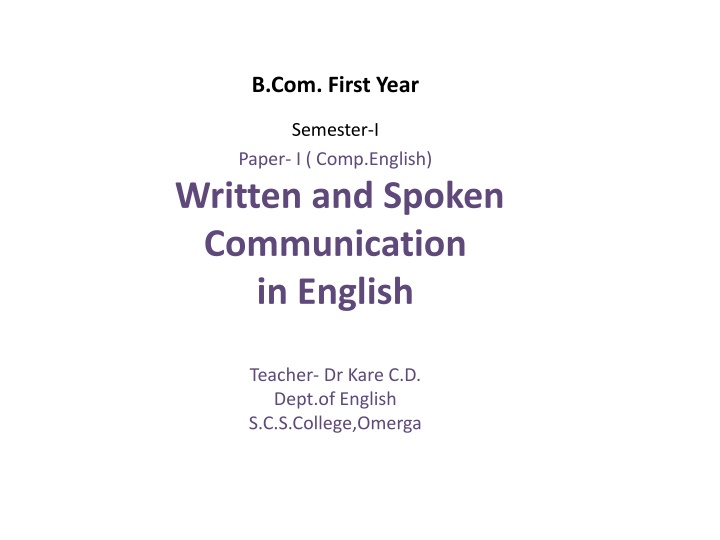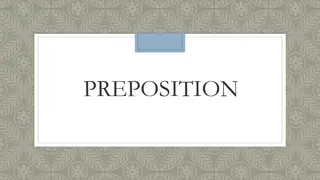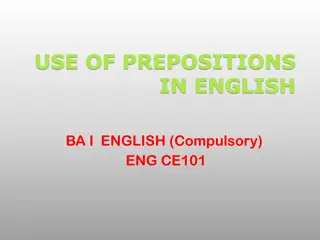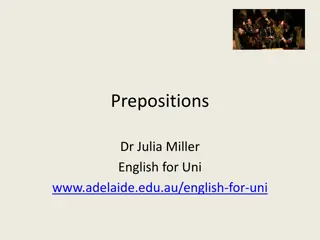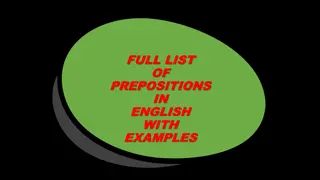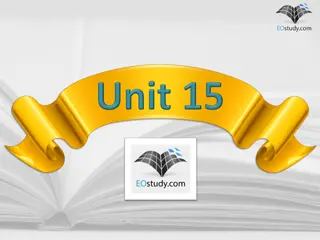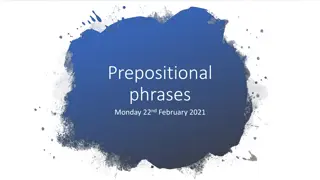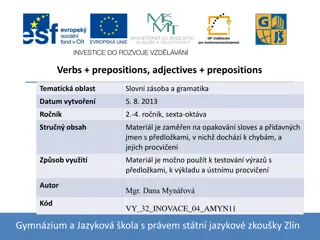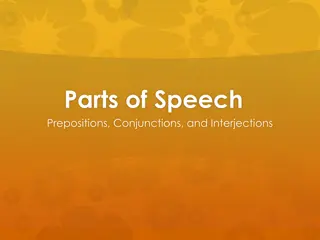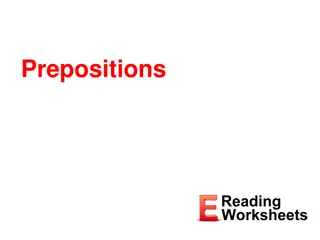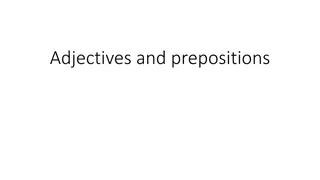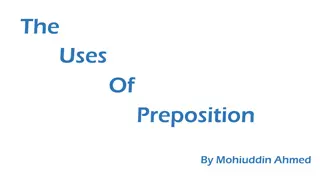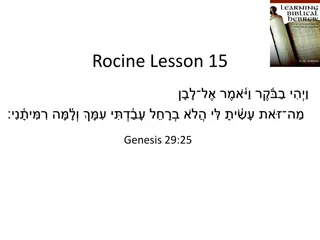Common Prepositions of Time and Position in English Usage
Detailed explanations and examples are provided for various common prepositions of time and position in English, including "at," "on," "in," "for," "since," "from," "between," "among," "above," "over," "below," "under," "in," "into," "to," "towards," "off," "across," "along," "behind," "besides," "beside," and "by." Each preposition is clearly defined and illustrated with relevant usage scenarios to aid in understanding their proper application in written and spoken English.
Download Presentation

Please find below an Image/Link to download the presentation.
The content on the website is provided AS IS for your information and personal use only. It may not be sold, licensed, or shared on other websites without obtaining consent from the author.If you encounter any issues during the download, it is possible that the publisher has removed the file from their server.
You are allowed to download the files provided on this website for personal or commercial use, subject to the condition that they are used lawfully. All files are the property of their respective owners.
The content on the website is provided AS IS for your information and personal use only. It may not be sold, licensed, or shared on other websites without obtaining consent from the author.
E N D
Presentation Transcript
B.Com. First Year Semester-I Paper- I ( Comp.English) Written and Spoken Communication in English Teacher- Dr Kare C.D. Dept.of English S.C.S.College,Omerga
Prepositions of Time: AT: a) At is used with a definite point of time E.g. At 7 p.m., at this moment b) With the names of festivals e.g. At Diwali, At Durga Puja On: It is used with days and dates e.g. On Monday, On first May, On the Annual Day In: It is used with parts of the day, months, years and seasons. e.g. In the morning, in the evening ( but At noon), in May, in 1942 In Winter For and Since: Foris used with periods of time. It is mostly used with present perfect continuous tense. e.g. The child has been sleeping for three hours.
Since: It marks the point of time. e.g. He has been teaching in this college since 2006. From: It denotes the starting point of an action. Used with to or till. e.g. a) The examination will be held from 8 a.m. to 11 a.m. b) He was the Chief Minister of this state from 1950 to 1962. Prepositions of Position: At and In : At has the idea of an exact point, and used with small towns and In has the idea of a larger area and is used while speaking of bigger Towns, states, countries etc. e.g. At Karol Bagh in New Delhi, At the bus stand, in England Between and Among: Between means in the middle of two ; it may be two persons or things. e.g. A Small table was lying between the two almirahs.
Among is used with more than two persons or things. e.g. Distribute these sweets among the children. Above and Over : Above means higher than. Over means vertically above. e.g. a) My house stands on a hilltop above the fields. b) There is a fan exactly over the table. Below and Under: Below means lower than. Under means vertically below. e.g. a) There was a beautiful lake below us in the valley. b) The traveler was resting under the tree. In and Into : Used to indicate enclosed location while Into is used showing movement From one position to another. e.g. a) He was in the class. b) He jumped into the well.
To and Towards: To has the sense of destination and towards denotes direction. e.g. a) He went to Delhi. b) The fielder was running towards the boundary. Off: off shows separation. e.g. a) He fell off the cycle. b) Take your hands off my books. Across: It means from one side to the opposite. e.g. He swam across the river. Along: means in the same line with. a) We went for a stroll along the seashore. Behind: means at the back of . e.g. a) They hid behind the curtain.
Besides: Means in addition to e.g. Besides Marathi,I can speak English. Beside: means by the side of e.g. He kept his school bag beside the water tank. By: a)shows nearness of some kind. e.g. Let us sit by the fireplace. b) By shows agency. Used in passive voice. e.g. Ravan was killed by Ram. Of : means belonging to e.g. The leg of the table, Hostel of the boys In some phrases like- i) afraid of- He is afraid of dogs. ii) tired of- The old man was tired of work. iii) Died of- He died of heart attack.
Through: Means across the interior of something. e.g. i) I could see through the hole. ii) He has passed through many difficulties. With : shows association, instrumentality e.g. i) He came back with his family. ii) She cut the lemon with a knife. Than: It denotes comparison or difference. It is hotter in Delhi than at Shimla. For: It denotes the following relations. Purpose- Walking is good for health. Reason- He was punished for theft. On behalf of- I shall fight for you. In spite of For all his defects, I love him.
